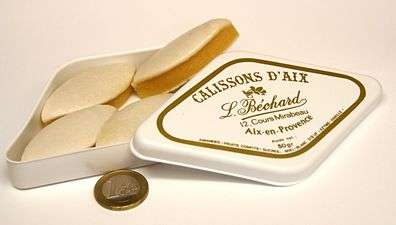Calisson
 | |
| Alternative names | canisson, canissoun |
|---|---|
| Type | Confectionery |
| Place of origin | France |
| Serving temperature | cold |
| Main ingredients | candied fruit (especially melons and oranges), almond meal or flour, fondant |
|
| |
Calissons are a traditional French candy consisting of a smooth, pale yellow, homogeneous paste of candied fruit (especially melons and oranges) and ground almonds topped with a thin layer of royal icing.[1] Calissons have a texture not unlike that of marzipan, but with a fruitier, distinctly melon-like flavor. Calissons are often almond-shaped and are typically about two inches in length. Calissons are traditionally associated with the town of Aix-en-Provence, France; consequently, most of the world supply of calissons are still made in the Provence region.
History
The calisson is believed to have its origins in medieval Italy. Among the first known references to calissons was in Martino di Canale's Chronicle of the Venetians in 1275. An earlier 12th century text written in Medieval Latin used the word calisone to refer to a cake made with almonds and flour. Yet another candy that is thought to be a relative of the modern calisson is kalitsounia, which was made with marzipan, nuts, and spices such as cinnamon and cloves and was found in places occupied by the Venetians, such as Crete.[2]
Some trace the introduction of calissons to Provence around the mid-15th century at the second wedding of King Rene of Anjou.[2] Others suggest that it was not introduced in its modern form until the 16th century, as this was when almonds became an established crop in Aix-en-Provence.[3]
References
- ↑ Hopkins, Kate (2012). Sweet tooth : the bittersweet history of candy (1st ed.). New York: St. Martin's Press. p. 112. ISBN 9780312668105.
- 1 2 Langer, Patrick (1999). Calissons d'Aix, Nougats de Provence. Equinox.
- ↑ "Calissons – Aix en Provence". Aix en Provence Tourism Office. Retrieved 25 January 2011.
External links
- http://www.aixenprovencetourism.com/uk/aix-calissons.htm
- http://www.calisson.com/
- http://www.bygilles.com/blogs/news/9884530-the-origin-of-calisson